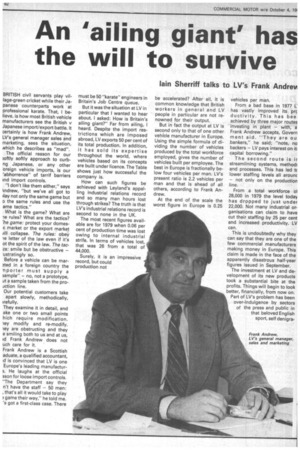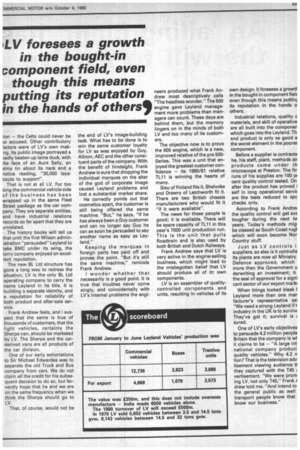An 'ailing giant' has the will to survive
Page 64

Page 65

If you've noticed an error in this article please click here to report it so we can fix it.
lain Sherriff talks to LV's Frank Andrem
BRITISH civil servants play village-green cricket while their Japanese counterparts work at professional karate. That, I believe, is how most British vehicle manufacturers see the British v Japanese import/export battle. It certainly is how Frank Andrew, LV's general manager sales and marketing, sees the situation, Nhich he describes as "mad". The official reason for our ;oftly softly approach to curbng Japanese, or any other °reign vehicle imports, is our 'abhorrence" of tarrif barriers ind import controls.
"I don't like them either," says kndrew, "but we've all got to 'lay not only the same game but D the same rules and use the ame tactics."
What is the game? What are le rules? What are the tactics? he game: protect your domesc market or the export market till collapse. The rules: obey le letter of the law even if it's ot the spirit of the law. The taccs: smile but be obstructive — ustratingly so.
Before a vehicle can be mar3ted in a foreign country the nporter must supply a sample" — no, not a prototype, Lt a sample taken from the proJction line.
Our potential customers take apart slowly, methodically, irefully.
They examine it in detail, and ake one or two small points hich require modification. )ey modify and re-modify. ley are obstructing and they e smiling both to us and at us, id Frank Andrew does not uch care for it.
Frank Andrew is a Scottish aduate, a qualified accountant, d is convinced that LV is one Europe's leading manufactur5. He laughs at the official 3son for loose import controls. ''The Department say they n't have the staff — 50 men: , that's all it would take to play game their way," he told me. 's got a first-class case. There
must be 50 "karate" engineers in Britain's Job Centre queue.
But it was the situation at LV in particular that I wanted to hear about. I asked: How is Britain's ailing giant?" Far from ailing, heard. Despite the import restrictions which are imposed abroad, LV exports 50 per cent of its total production. In addition, it has sold its expertise throughout the world, where vehicles based on its concepts are built under licence. The Table shows just how successful the company is.
How can such figures be achieved with Leyland's appalling industrial relations record and so many man hours lost through strikes? The truth is that LV's industrial relations record is second to none in the UK.
The most recent figures available are for 1979 when 0.06 per cent of production time was lost owing to internal industrial strife. In terms of vehicles lost, that was 26 from a total of 44,000.
Surely, it is an impressive record, but could production not be accelerated? After all, it is common knowledge that British workers in general and LV people in particular are not renowned for their output.
But in fact the output at LV is second only to that of one other vehicle manufacturer in Europe. Using the simple formula of dividing the number of vehicles produced by the total workforce employed, gives the number of vehicles built per employee. The best in Europe is fractionally below four vehicles per man. LV's present ratio is 2.2 vehicles per man and that is ahead of all others, according to Frank Andrew.
At the end of the scale the worst figure in Europe is 0.25 vehicles per man.
From a bad base in 1977 L' has vastly improved its prc ductivity. This has bee achieved by three major routes investing in plant — with, a Frank Andrew accepts, Govern ment aid. "They are ou bankers," he said; "note, no backers — LV pays interest on it: capital borrowing."
The second route is ir streamlining systems, method: and processes. This has led tc lower staffing levels all arounc — not only on the production line.
From a total workforce oi 28,000 in 1979 the level today has dropped to just under 22,000. Not many industrial organisations can claim to have cut their staffing by 25 per cent and increased productivity. LV can.
This is undoubtedly why they can say that they are one of the few commercial manufacturers making money in Europe. This claim is made in the face of the apparently disastrous half-year figures issued in September.
The investment at LV and development of its new products took a substantial bite at the profits. Things will begin to look better, financially, from now on. Part of LV's problem has been over-indulgence by sectors of the press and public in that beloved English sport, self denigra
.ion — the Celts could never be ;o accused. Other contributory 'actors were of LV's own makng. Its public image portrayed a aadly beaten-up lame duck, with :he face of an Aunt Sally, an 3 I m s tin about its neck and a lotice reading, "30,000 layabouts to support".
That is not at all LV. For too long the commercial vehicle side of the business has been wrapped up in the same Fleet Street package as the car company. They are separate entities, and have industrial relations records so far apart that they are unrelated.
The history books will tell us that until the first Wilson administration "persuaded" Leyland to take BMC under its wing, the lorry company enjoyed an excellent reputation.
The new BL Ltd structure has gone a long way to redress the situation. LV is the only BL Ltd operating company to carry the name Leyland in its title. It is building a separate identity, and a reputation for reliability of both product and after-sale service.
Frank Andrew feels, and I suspect that the same is true of thousands of customers, that the light vehicles, certainly the Sherpa van, should be marketed by LV. The Sherpa and the carderived vans are all products of the car division.
One of our early exhortations to Sir Michael Edwardes was to separate the old Truck and Bus company from cars. We do not claim all the credit for his subsequent decision to do so, but fervently hope that he and we are on the same frequency when we think the Sherpa should go to LV.
That, of course, would not be the end of LV's image-building task. What has to be done is to win the same customer loyalty for LV as was enjoyed by Guy, Albion, AEC and the other consituent parts of the company. With the benefit of hindsight, Frank Andrew is sure that dropping the individual marques on the altar of the god of corporate image caused Leyland problems and lost a substantial market share.
He correctly points out that cosmetics apart, the customer is still being offered the same machine. "But," he says, "if he has always been a Guy customer and can no longer say Guy he can as soon be persuaded to say another name as easy as Leyland."
Keeping the marques in foreign parts has paid off and proves the point. "But it's still the same machine," reminds Frank Andrew.
I wonder whether that necessarily is a good point. It is true that troubles never come singly, and coincidentally with LV's internal problems the engi
neers produced what Frank Andrew most descriptively calls "The headless wonder." The 500 engine gave Leyland management more problems than managers can count. These days are behind them, but the memory lingers on in the minds of both LV and too many of its customers.
The objective now is to prove the 600 engine, which is a new, improved relative of the pre 500Series. This was a unit that enjoyed the greatest customer confidence — its 1980/81 relative TL11 is winning the hearts of many.
Sisu of Finland fits it, Shelvoke and Drewry of Letchworth fit it. There are two British chassis manufacturers who would fit it "if it were available".
The news for these people is good; it is available. There will be spare capacity of TL11 in this year's 7000 unit production run. This is the unit that pulls Roadtrain and is also used by both British and Dutch Railways.
Frank Andrew says that LV is very active in the engine-selling business, which might lead to the misbegotten belief that LV should produce all of itc own components.
LV is an assembler of qualitycontrolled components and units, resulting in vehicles of its own design. It foresees a growth in the bought-in component fielc even though this means puttinc its reputation in the hands o others.
Industrial relations, quality c materials, and skill of operative are all built into the componer which goes into the Leyland. Th end product is only as good a the worst element in the poore; component.
Before a supplier is contracte he, his staff, plant, methods an products come under th microscope at Preston. The fir: runs of his supplies are 100 IN cent quality control tested. On after the product has proved i self in long operational servi( are the tests reduced to spa checks only.
According to Frank Andre% the quality control will get eve tougher during the next tv% years. Today's methods mig be classed as South Coast rug t which will soon become Nor Country stuff.
Just as LV controls i suppliers, so also is it controlle Its plants are now all Ministry Defence approved, which more than the Government u derwriting an investment; it the seal of approval for a signi cant sector of our export markt When things looked bleak f Leyland more than one mar facturer's representative sai "We need a strong Leyland if t industry in the UK is to surviv( They've got it; survival is t sured.
One of LV's early objectives to persuade 4.2 million people Britain that the company is wt it claims to be — "A large int national company produci quality vehicles." Why 4.2 n lion? That is the television adv tisement viewing audience tl they captured with the T45 4 vertisement. "We were prom ing LV, not only T45," Frank / drew told me. "And intend to the general public as well transport people know that know our business."












































































































